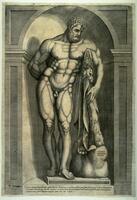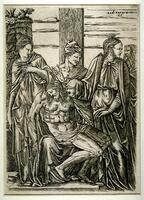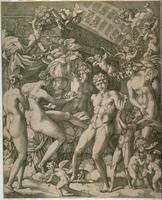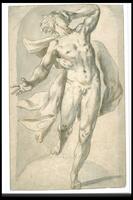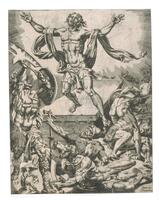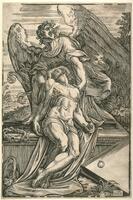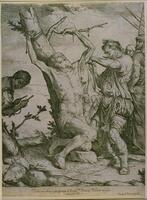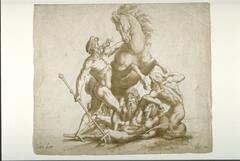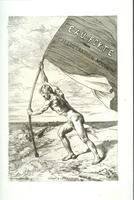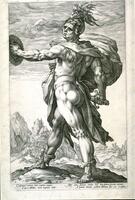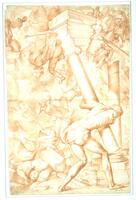Fall
- 1994/2.17 - The Farnese Hercules, Jacob Bos, 1562; 18 1/8 in. x 12 5/8 in.
- 1970/1.179 – Lamentation, Bartolommeo da Brescia, 1565; 10 5/8 in. x 7 11/16 in.
- 1985/1.86 - Mars and Venus Surrounded by Nymphs and Putti, Giovanni Jacopo Caraglio, circa 1530-1540; 16 1/2 in. x 13 3/16 in.
- 1979/1.153 - The Dead Christ Supported by an Angel, Giuseppe Scolari, circa 1582; 18 1/8 in. x 12 3/16 in.
Winter
- 1954/2.54 - Study of a Male Nude with Floating Drapery, Isaac Claesz van Swanenburg, 1562-1638; 12 7/16 in. x 7 15/16 in.
- 1983/2.249 - The Resurrection, Marten van Heemskerck, 1548-1574; 8 3/8 in. x 5 9/16 in.
- 1957/1.33 - The Martyrdom of St. Bartholomew, Jusepe de Ribera, 1624; 13 1/2 in. x 10 3/8 in.
7 Items in this Learning Collection
Collection Object
Collection Object
Collection Object
Collection Object
Collection Object
Collection Object
Collection Object
Copyright
All Rights Reserved
()
Study of a Male Nude with Floating Drapery
Accession Number
1954/2.54
Title
Study of a Male Nude with Floating Drapery
Artist(s)
Object Creation Date
1562-1638
Medium & Support
pen, brown ink and gray wash on laid paper
Dimensions
12 1/2 x 7.9 in. (31.59 x 20.16 cm);12 1/2 x 7.9 in. (31.59 x 20.16 cm);19 1/4 x 14 3/8 in. (48.89 x 36.51 cm)
Credit Line
Museum Purchase
Label copy
March 28, 2009
This arresting study of a male nude combines a masterful portrayal of anatomy with a powerful evocation of movement and emotional intensity. The intricate pose and the dramatic elaboration of each element of the nude’s body give the figure a striking yet overwrought quality. Such excessive complexity was appreciated in the period as a sign of creativity and a conspicuous display of artistry.
The self-conscious cultivation of artistic difficulty seen in the figure’s elaborate pose was the key feature of a style that scholars have termed Mannerism. The style emerged in Rome in the 1520s among followers of Raphael and Michelangelo, and spread throughout Europe over the course of the sixteenth century. The relationship between this drawing and two prints also displayed here—Marten van Heemskerck’s The Resurrection and Hendrick Goltzius’s Calphurnius—as well as the painting The Flood, which hangs nearby, demonstrates the influence of Mannerism in the Netherlands.
Subject matter
The intricate pose and dramatic elaboration of each element of the nude's body--the well-muscled torso, the foreshortened arms, the striding legs--give the figure a striking yet overwrought quality. Such excessive complexity was appreciated in the period as a sign of creativity and a conspicuous display of artistry. The self-conscious cultivation of artistic difficult seen in this drawing was a key feature of a style popular in the mid- to late sixteenth century that scholars have termed Mannerism.
Physical Description
This study of a male nude set within a niche combines a skilled portrayal of anatomy with a powerful evocation of movement and emotional intensity. Through the carefully rendered arms and swirling draperies the artist expands and animates the space around the figure, who seems to surge forward even as he turns his head back in a gesture of despair.
Primary Object Classification
Drawing
Primary Object Type
study
Collection Area
Western
Rights
If you are interested in using an image for a publication, please visit http://umma.umich.edu/request-image for more information and to fill out the online Image Rights and Reproductions Request Form.
Keywords
Mannerist (Greek vase painting style)
drapery (representations)
drawing (image-making)
nudes (representations)
preparatory drawings
1954/2.54
Title
Study of a Male Nude with Floating Drapery
Artist(s)
Object Creation Date
1562-1638
Medium & Support
pen, brown ink and gray wash on laid paper
Dimensions
12 1/2 x 7.9 in. (31.59 x 20.16 cm);12 1/2 x 7.9 in. (31.59 x 20.16 cm);19 1/4 x 14 3/8 in. (48.89 x 36.51 cm)
Credit Line
Museum Purchase
Label copy
March 28, 2009
This arresting study of a male nude combines a masterful portrayal of anatomy with a powerful evocation of movement and emotional intensity. The intricate pose and the dramatic elaboration of each element of the nude’s body give the figure a striking yet overwrought quality. Such excessive complexity was appreciated in the period as a sign of creativity and a conspicuous display of artistry.
The self-conscious cultivation of artistic difficulty seen in the figure’s elaborate pose was the key feature of a style that scholars have termed Mannerism. The style emerged in Rome in the 1520s among followers of Raphael and Michelangelo, and spread throughout Europe over the course of the sixteenth century. The relationship between this drawing and two prints also displayed here—Marten van Heemskerck’s The Resurrection and Hendrick Goltzius’s Calphurnius—as well as the painting The Flood, which hangs nearby, demonstrates the influence of Mannerism in the Netherlands.
Subject matter
The intricate pose and dramatic elaboration of each element of the nude's body--the well-muscled torso, the foreshortened arms, the striding legs--give the figure a striking yet overwrought quality. Such excessive complexity was appreciated in the period as a sign of creativity and a conspicuous display of artistry. The self-conscious cultivation of artistic difficult seen in this drawing was a key feature of a style popular in the mid- to late sixteenth century that scholars have termed Mannerism.
Physical Description
This study of a male nude set within a niche combines a skilled portrayal of anatomy with a powerful evocation of movement and emotional intensity. Through the carefully rendered arms and swirling draperies the artist expands and animates the space around the figure, who seems to surge forward even as he turns his head back in a gesture of despair.
Primary Object Classification
Drawing
Primary Object Type
study
Collection Area
Western
Rights
If you are interested in using an image for a publication, please visit http://umma.umich.edu/request-image for more information and to fill out the online Image Rights and Reproductions Request Form.
Keywords
Mannerist (Greek vase painting style)
drapery (representations)
drawing (image-making)
nudes (representations)
preparatory drawings
